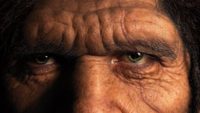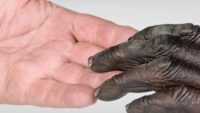By Dr. Timothy Clarey The BioLogos Foundation published a popular-level article by old-earth geologists Gregg Davidson and Ken Wolgemuth presenting arguments for an old earth. …read more Read more here: AIG Daily
In the early days of genetics, genes were thought to be solitary entities. Now it’s well understood that genes operate in complex networks and that gene mutations can have multiple detrimental effects. A new study reconfirms mutations are a major roadblock for evolution. More… …read more Read more here: icr.org
Evolutionary scientists recently announced another spectacular dinosaur discovery. They nicknamed this one the Mud Dragon because it seems it died buried in mud. Junchang Lü and co-authors describe the new oviraptorid dinosaur in Scientific Reports. How did it really die? More… …read more Read more here: icr.org
Evolutionists have faith that a fish can evolve from water in a bathtub, given a billion years. …read more Read more here: creation.com
Tongtianlong limosus-More feathered-dinosaur story telling that doesn’t stand up to scrutiny. …read more Read more here: creation.com
By Dr. Danny R. Faulkner Why did they pick November 28 as Red Planet Day? On November 28, 1964, NASA launched Mariner 4, the first successful space probe to visit the planet Mars. …read more Read more here: AIG Daily
By Dr. Andrew A. Snelling Why would the Southeastern USA experience such a devastating earthquake, a region that sits snugly in the middle of a tectonic plate? …read more Read more here: AIG Daily
By Warren H. Johns The place of the biblical Flood in the geological record remains one of the most hotly debated issues among creationist geologists today. …read more Read more here: AIG Daily
By Dr. Elizabeth Mitchell Hailed as a transitional form between modern snakes and their supposed lizard ancestors, Tetrapodophis amplectus is now the subject of heated controversy. …read more Read more here: AIG Daily
By Dr. Elizabeth Mitchell A while back many were shocked to learn that Neanderthal genes and Denisovan genes were present in the genomes of many modern people. …read more Read more here: AIG Daily
Accelerated radioisotope decay may have caused geologic upheaval on the red planet, similar to what occurred on Earth. …read more Read more here: creation.com
Triceratops soft tissue found and carbon dated …read more Read more here: creation.com
A marvel of agility and patience waits poised among the branches of our garden plants … …read more Read more here: creation.com
Due to the complete lack of transitional fossils leading to the remarkable pangolin, secular scientists must resort to “just-so stories” to fill in evolution’s significant blanks, including how this amazing creature got its scales. Ricki Lewis, a Ph.D. geneticist, did exactly that with her recent article, “How the Pangolin Got Its Scales—A Genetic Just-So Story.” More… …read more Read more here: icr.org
The hunter so well designed it perfectly fits into a specific habitat. …read more Read more here: creation.com
Pseudogenes were once thought to be genomic fossils—the broken remnants of genes that mutated long ago. However, research is progressively showing that many pseudogenes are highly functional and critical to life. Now, a newly characterized pseudogene has been shown to produce a functional protein, but only in cells where it is required—leading researchers to coin a new term pseudo-pseudogene. More… …read more Read more here: icr.org
By Jeffrey P. Tomkins The current chimpanzee genome assembly has problems that reduce its veracity as an authentic representation. …read more Read more here: AIG Daily
By Dr. Danny R. Faulkner Scientists increasingly talk and write about the multiverse. What is the multiverse? The multiverse is the belief that our universe is just one of many. …read more Read more here: AIG Daily
Carbon-14 in Diamonds is still a problem for evolutionists. …read more Read more here: creation.com
Is a mutation that seemingly reduces risk of cardiovascular disease an example of evolution in action? …read more Read more here: creation.com
By Dr. David Menton Dogs are always sniffing around, but it’s not because they’re always hungry. Unlike us, they interpret the world primarily through smell. …read more Read more here: AIG Daily
Buried bones, ancient carvings, and cave paintings reveal early European cow-types. Some had the large shoulder humps of bison, some showed the big horns of the extinct aurochs—extinct ancestors of modern cattle—and others seemed like hybrids between these forms. Classic Darwinian evolution asserts one ancestor for various descendants. These supposedly separate into isolated species which can’t breed, like tree branches extending far from their trunk. A recent study exposed how this concept clashes with the actual trends in cow-kind variation. More… …read more Read more here: icr.org
Man looked to the birds, and conquered the skies. Now researchers are looking to imitate a much tinier winged creature … …read more Read more here: creation.com
A theory divided against itself: a ‘primitive’ creature is ‘superior’! …read more Read more here: creation.com
By Jean O’Micks Until now there have been two basic theories on the evolution of cellular complexity. …read more Read more here: AIG Daily
Did God use the Big Bang to create the universe? Can we know the age of the earth? ICR physicist Dr. Jake Hebert explores the origin of the universe, recent Ice Age studies, and the relevance of earth age research. Also, learn more about Dr. Hebert as he shares his personal creation journey. More… …read more Read more here: icr.org
By Dr. Andrew A. Snelling Evidently, just prior to both periods, massive tectonic collisions took place near the earth’s equator—a tropical zone where rocks undergo heavy weathering. …read more Read more here: AIG Daily











































![Creation Physics [Podcast] Creation Physics [Podcast]](http://proofthebibleistrue.com/wp-content/uploads/2016/11/67426-thumb-200x124.jpg)
